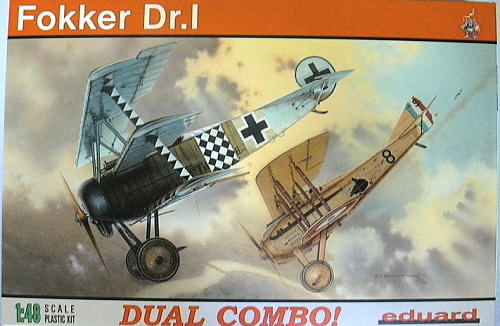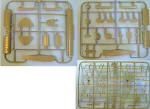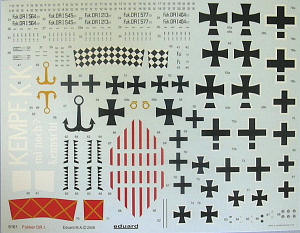Eduard 1/48 Fokker
Dr.I 'Dual Combo'
|
KIT #: |
8161 |
|
PRICE: |
39.95 MSRP |
|
DECALS: |
Six options |
|
REVIEWER: |
Tom
Cleaver |
|
NOTES: |
|

The Fokker Dr.I Triplane is easily the most-recognizable airplane of the First
World War.
People who know nothing else about First World War aviation know
what a Fokker Triplane is.
The Triplane is also easily the first “celebutante” airplane, being mostly
famous for being famous.
The airplane was the result of
Idflieg - the German Air Force high command - being bowled
over by the performance of the Sopwith Triplane, which had appeared over the
Western Front in March 1917 and proven itself one of the best Allied fighters
during “Bloody April.”
This was not unlike the hoorah in German air Force
circles the year before after the appearance of the Nieuport sesquiplane
fighter, which resulted in the Albatros series losing their excellent biplane
design for replacement by the aerodynamically-weak sesquiplane layout.
By the summer of 1917, when Idflieg was actively soliciting detailed project
submissions from the German aircraft industry, the Tripehound was already
leaving British service, since the tactics of the air war were changing so that
a relatively slow - even if highly-maneuverable - fighter was now outclassed by
contemporary designs like the SPAD series, the S.E.5 or the Sopwith Camel.
Even so, the war in the air was still such that a fighter like the Tripehound
could have been a solid performer as late as the fall of 1917.
Unfortunately for the Dr.I, the airplanes were all
grounded at that point due to Fokker’s notoriously shoddy quality control in the
factory.
By the time the Triplane was finally cleared for unlimited service in
January 1918, the day of such a dogfighter was past.
The Triplane could outmaneuver its enemies, but it could
neither catch them nor outrun them, the new tactic for fighters, nor could it
fly well at the altitudes air combat was now taking place at.
The Triplane is primarily famous for being flown by famous German pilots.
During the first six months of 1918, it was nearly the
only German fighter not outclassed by their opponents, which is why so much
effort was expended on the First Fighter Competition and in getting the Fokker
D.VII into widescale production.
After May 1918, as the D.VII became progressively more
available, the Dr.I disappeared from the front.
Interestingly enough, aeronautical experts have now shown that the Dr.I was an
inferior triplane design to the Sopwith.
Unlike the British fighter, which had small ailerons on
each wing, the Dr.I had large ailerons on the upper wing only.
Thus, aerodynamically, the Sopwith’s wings were all
working together while the Dr.I was dragging two wings that wanted to fly
straight and level while fighting increased adverse aileron yaw from the larger
ailerons.
Nevertheless, despite its failings, the fact is that the Dr.I is the most famous
airplane of the First World War.
It is an interesting, distinctive-looking airplane, and
all those famous pilots made sure each flew one that looked different from
everyone else, so there is a plethora of marking possibilities.
 The Fokker Triplane was an early candidate for production as plastic models
began, and was - if I remember correctly - the first or second release by Aurora
when that company began producing World War I models in the mid-Fifties.
Revell released a 1/28 Triplane that is still available
and still makes up into an excellent model out of the box, that can be made
better by a modeler willing to expend a bit of extra effort.
The Aurora kit wasn’t replaced until Dragon brought out
their 1/48 Dr.I in 1990.
This kit has the “fatal flaw” (which most modelers can
cure with about 45 minutes of effort with a sanding stick) of an incorrect
representation of the lower wing fabric surface.
Past that, it is still a good model, other than for the
fact it has now been out of production long enough to command collector’s prices
that keep it from being built that often.
The Fokker Triplane was an early candidate for production as plastic models
began, and was - if I remember correctly - the first or second release by Aurora
when that company began producing World War I models in the mid-Fifties.
Revell released a 1/28 Triplane that is still available
and still makes up into an excellent model out of the box, that can be made
better by a modeler willing to expend a bit of extra effort.
The Aurora kit wasn’t replaced until Dragon brought out
their 1/48 Dr.I in 1990.
This kit has the “fatal flaw” (which most modelers can
cure with about 45 minutes of effort with a sanding stick) of an incorrect
representation of the lower wing fabric surface.
Past that, it is still a good model, other than for the
fact it has now been out of production long enough to command collector’s prices
that keep it from being built that often.
The new Eduard kit is truly state of the art.
Eduard has decided to do kits of airplanes that have
previously been released by other manufacturers, but to produce something that
is “definitive.”
This kit meets that standard.
 All plastic detail parts are extremely petite.
The airframe itself is nicely done with a realistic
fabric representation.
Trailing edges of wings are nice and sharp.
The cockpit is well-detailed and those plastic parts are
set off by great photoetch parts.
The kit includes the correct horizontal stabilizer and
early-production ailerons to allow a modeler to do the F.1 production
prototypes.
All plastic detail parts are extremely petite.
The airframe itself is nicely done with a realistic
fabric representation.
Trailing edges of wings are nice and sharp.
The cockpit is well-detailed and those plastic parts are
set off by great photoetch parts.
The kit includes the correct horizontal stabilizer and
early-production ailerons to allow a modeler to do the F.1 production
prototypes.
Decals are provided for no less than six different famous airplanes, most of
which have never been done before by anyone (other than the famous “Kempf”
triplane) with a separate sheet of stencils. (Editor's
note: I've seen at least two of these on a
Blue Rider 1/72 sheet
so it may be appropriate to say most have not been seen in 1/48 before)
Did I mention there are TWO complete
kits here?
With two kits and enough decals to do both differently, this is a
real bargain at a MSRP of $39.95.
The Fokker Triplane is easy enough to build that any
modeler who has yet to do a World War I airplane could start with this kit, in
anticipation of doing a show-stopper the first time out.
There is no World War I modeler alive who can resist two
perfect Dr.I kits for a price less than the Dragon kit on eBay.
Highly recommended.
Thanks to Eduard for the
review kit.
August 2008
If you would like your product reviewed fairly and fairly quickly, please contact the editor or see other details in the
Note to
Contributors.
Back to the Main Page
Back to the Previews Index Page


 The Fokker Triplane was an early candidate for production as plastic models
began, and was - if I remember correctly - the first or second release by Aurora
when that company began producing World War I models in the mid-Fifties.
Revell released a 1/28 Triplane that is still available
and still makes up into an excellent model out of the box, that can be made
better by a modeler willing to expend a bit of extra effort.
The Aurora kit wasn’t replaced until Dragon brought out
their 1/48 Dr.I in 1990.
This kit has the “fatal flaw” (which most modelers can
cure with about 45 minutes of effort with a sanding stick) of an incorrect
representation of the lower wing fabric surface.
Past that, it is still a good model, other than for the
fact it has now been out of production long enough to command collector’s prices
that keep it from being built that often.
The Fokker Triplane was an early candidate for production as plastic models
began, and was - if I remember correctly - the first or second release by Aurora
when that company began producing World War I models in the mid-Fifties.
Revell released a 1/28 Triplane that is still available
and still makes up into an excellent model out of the box, that can be made
better by a modeler willing to expend a bit of extra effort.
The Aurora kit wasn’t replaced until Dragon brought out
their 1/48 Dr.I in 1990.
This kit has the “fatal flaw” (which most modelers can
cure with about 45 minutes of effort with a sanding stick) of an incorrect
representation of the lower wing fabric surface.
Past that, it is still a good model, other than for the
fact it has now been out of production long enough to command collector’s prices
that keep it from being built that often.